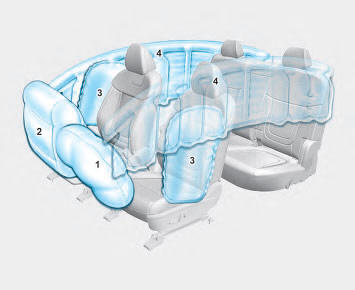Hyundai Santa Cruz: Seats & Safety System / Air Bag - Supplemental Restraint system

1. Driver’s front air bag
2. Passenger’s front air bag
3. Side air bag
4. Curtain air bag
This vehicle is equipped with a Supplemental Air Bag System for the driver’s seat and front passenger’s seats.
The front air bags are designed to supplement the three-point seat belts. For these air bags to provide protection, the seat belts must be worn at all times when driving.
You can be severely injured or killed in an accident if you are not wearing a seat belt. Air bags are designed to supplement seat belts, but do not replace them. Also, air bags are not designed to deploy in every collision. In some accidents, the seat belts are the only restraint protecting you.
WARNING
AIR BAG SAFETY PRECAUTIONS
ALWAYS use seat belts Child Restraint Systems - every trip, every time, everyone! Even with air bags, you can be seriously injured or killed in a collision if you are improperly belted or not wearing your seat belt when the air bag inflates.
NEVER place a child in any Child Restraint System or booster seat in the front passenger seat, unless the air bag is deactivated.
An inflating air bag could forcefully strike the infant or child causing serious or fatal injuries.
ABC - Always Buckle Children under age 13 in the back seat. It is the safest place for children of any age to ride. If a child age 13 or older must be seated in the front seat, he or she must be properly belted and the seat should be moved as far back as possible.
All occupants should sit upright with the seatback in an upright position, centered on the seat cushion with their seat belt on, legs comfortably extended and their feet on the floor until the vehicle is parked and the vehicle is turned off. If an occupant is out of position during an accident, the rapidly deploying air bag may forcefully contact the occupant causing serious or fatal injuries.
You and your passengers should never sit or lean unnecessarily close to the air bags or lean against the door or center console.
Move your seat as far back as possible from front air bags, while still maintaining control of the vehicle. The U.S. National Highway Traffic Safety Administration (NHTSA) recommends that drivers allow at least 10 inches (25 cm) between the center of the steering wheel and the chest.
- Where are the Air Bags?
- How does the SRS Air Bag System Operate?
- What to expect after an air bag inflates
- Occupant Classification System (OCS)
- Why didn’t my air bag go off in a collision?
- SRS Care
- Additional Safety Precautions
- Air Bag Warning Labels
 Securing a Child Restraint System
with a lap/shoulder belt
Securing a Child Restraint System
with a lap/shoulder belt
WARNING
ALWAYS place a rearward-facing Child
Restraint System in the rear seat of the
vehicle.
Placing a rearward-facing child restraint
in the front seat can result in serious
injury or death if ...
 Where are the Air Bags?
Where are the Air Bags?
Driver’s and passenger’s front air
bags
Your vehicle is equipped with a
Supplemental Restraint System (SRS)
as well as lap/shoulder belts at both the
driver and passenger seating positions.
T ...
Other information:
Hyundai Santa Cruz (NX4A OB) 2021-2025 Service Manual: Rear Differential Carrier
- Components Location
1. Rear differential carrier assembly2. Rear driveshaft assembly3. Coupling Assembly4. Propeller shaft assembly
- Components
1. Pinion lock nut2. Oil seal (pinion side)3. Pinion outer bearing4. Oil seal (case side)5. Packing6. Drain plug7. Differential carrier ca ...
Hyundai Santa Cruz (NX4A OB) 2021-2025 Service Manual: Crash Pad Lower Panel
- Component Location
1. Crash pad lower panel
- Replacement
• When removing with a flat-tip screwdriver or remover, wrap protective tape around the tools to prevent damage to components.
• Put on gloves to prevent hand injuries.
• Tak ...
